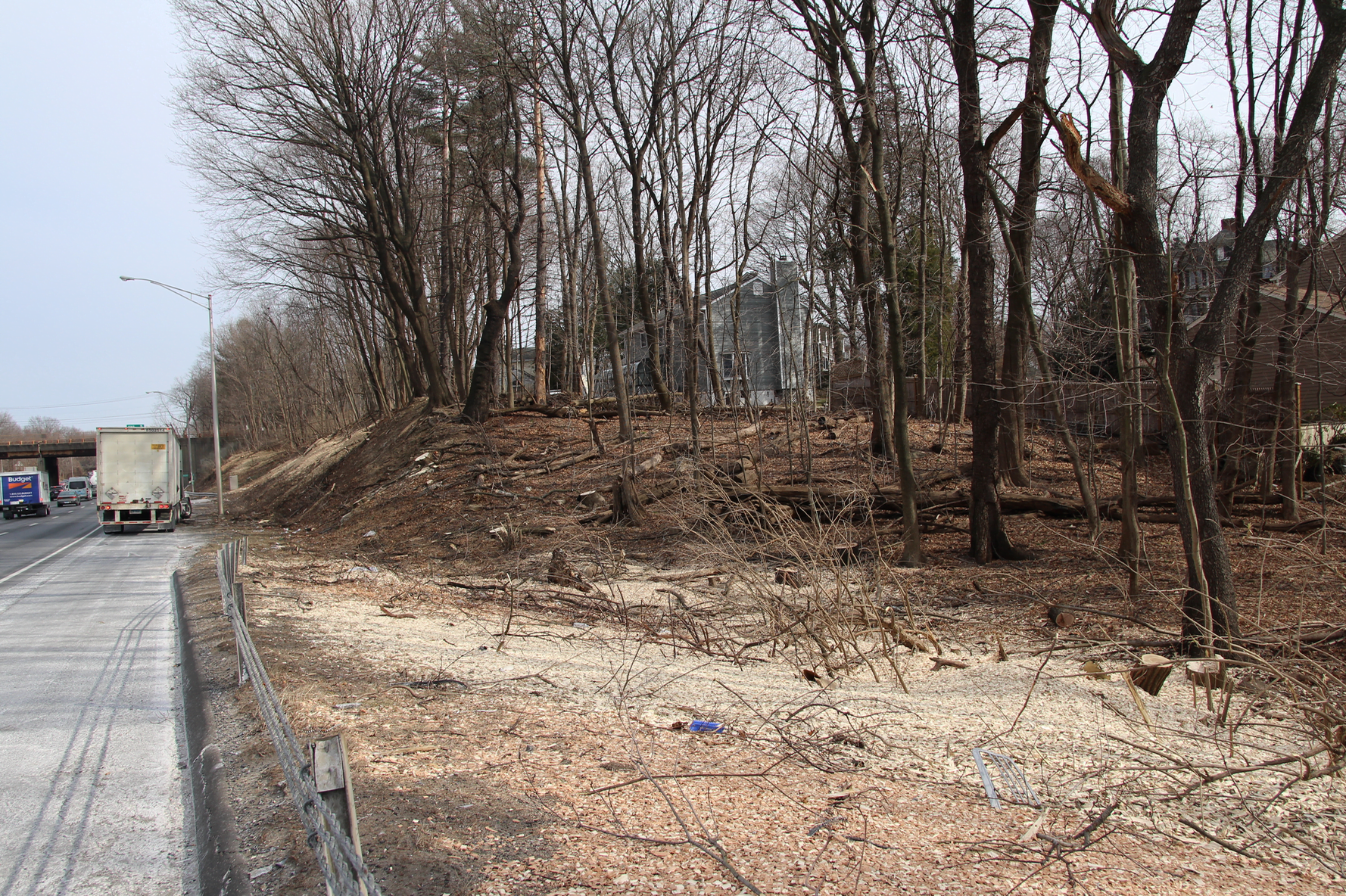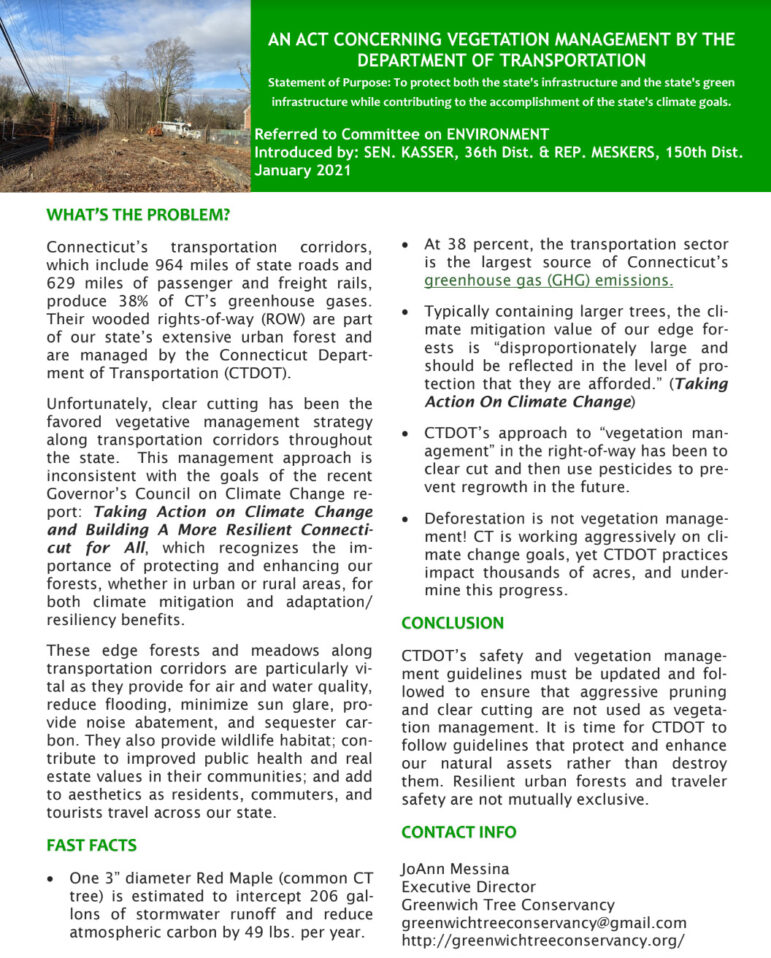Greenwich ought to coordinate the voices of interested parties for vegetation management along I-95 and come up with an ambitious wish list of items including sound barriers and guard rails in connection with the upcoming Dept of Transportation project on I-95 between Exits 2 and 6.
That was the resounding message of Wednesday’s P&Z Greenscape committee discussion attended by DPW deputy commissioner Jim Michel, State Rep Steve Meskers, and JoAnn Messina, who is the director of the Greenwich Tree Conservancy.
Messina said her organization had worked with the town to plant 4,500 trees on public land in Greenwich over the past 14 years, created a Town arboretum and worked on vegetation management with PURA, which has regulatory authority over utilities, including Eversource.
But, she noted, the Dept of Transportation does not have a regulatory authority.
Messina said it was time to propose legislation and that Senator Alex Kasser and State Rep Steve Meskers had offered offered to sponsor a bill.
Mr. Meskers said before a bill could be drafted, a public hearing should be held.
Messina said it was difficult to reconcile the knowledge that trees are a weapon against climate change with the Dept of Transportation seeking to clear cut trees “…without talking about it, without mapping them, without knowing what they are, and then, more importantly, having no interest in replanting.”
The focus of the Greenscape committee has been to landscape and beautify the six-mile Route 1 corridor from Port Chester to Stamford, with projects including a hundreds of spring flowering bulbs and a Chestnut Allée in the large island at the foot of Stanwich Rd (across from Pizza Post).
They agreed it might be wise to give suggestions to the state Dept of Transportation for a similar vision for I-95 from exit 2-6.

Mr. Michel from DPW said he would draft a joint letter that would come from First Selectman Fred Camillo and be co-signed by departments including DPW, Parks & Trees, and Conservation asking that a variety of items be included in the I95 project.
He said the DOT project managers reported receiving over 135 emails since the Jan 21, 2021 public hearing, and that the meeting had the highest attendance of any public meeting since the DOT moved their meetings to Zoom.
Mr. Michel said the DOT had no plans to do sound studies for sound barriers.
“In order to get a study done, typically they need a full lane addition,” he said, adding that was why sound barriers were erected in Darien where an acceleration/deceleration lane was added.
He suggested Greenwich’s elected officials – State Rep Steve Meskers, State Senator Alex Kasser, State Rep Kim Fiorello and State Rep Harry Arora – work together to try to at least get a sound study done so they might later seek funding for sound barriers.
“The whole idea that we have to gather together to ask our state not to clear cut large swaths of trees along residential neighborhoods is just astounding to me.”
John Conte, a landscape architect and licensed arborist, Greenscape Committee member
Mr. Michel said the bulk of the tree removal had to do with accessing catch basins and pipes for maintenance.
He also suggested the Greenscape committee come up with a wish list in the next few weeks, followed by a more detailed plan in the next few months, and offered to incorporate their “ask” in the joint letter with Mr. Camillo.


State Rep Steve Meskers said Greenwich should push back on the issues of vegetation and sound barriers.
“We should think more ambitiously and aggressively than we think what their precepts are,” Meskers said. “We need to knock and ask a little harder….They’re beginning to feel the heat and they are becoming more attentive.”
Meskers said he had spoken to the Dept of Transportation liaison Pam Sucato. “I said, look, ‘There has been an assault visually on I-95, and now you’re coming in for your last go round for the next 30 to 40 years.’ I said, ‘You’re going to get push back from every degradation of the last 4-5 years that have stripped trees and vegetation in a very high residential neighborhood. This is not Bridgeport; you’re not surrounded by factories on 95 here.”
Meskers he anticipated the Dept of Transportation might cite a lack of funding for vegetation or sound barriers, and that it might be necessary to appeal to the DOT commissioner, Senator Richard Blumenthal, Congressman Jim Himes, or even DEEP.
“We just have to look and figure out where the resources are,” he said. “Their mandate is to make straight the roads, and we’re in the way.”
Guard Rails
Mary Hull, the director of Green & Clean, suggested pushing for attractive wood backed guard rails like the ones on the Merritt Parkway. She said they were not much more difficult to maintain than the unattractive metal ones.
Susan Foster said the town “cannot cave” on getting aesthetically pleasing, attractive guard rails, especially at the exit loop at Exit 5 by Riverside Commons.
“We have to fight to get what’s on the Merritt at least in that section,” she said. “We can’t just accept the cheapest.”
Wildflowers VS Shrubs and Small Trees
Jim Michel said the state had expressed willingness to plant wildflowers along the highway in the area of Exit 3-4 where the sewer line runs, and where trees were clear cut a few years ago.
“They are willing to do some wildflower seed mix there. That’s about the extent of it,” Mr. Michel said. “We don’t necessarily disagree because there is a significant sanitary sewer infrastructure that carries sanitary sewer for 3/4 of the town in that area. In addition, they need access to their railroad.”
Mary Hull pointed out that flowers are only visible part of the year, and that shrubs and small trees would be better.
“It is much more complicated to manage wildflowers than it would be if we used good sized bushes and wood chips that won’t hurt them,” she said.
“If we can use practical trees – if they’ll allow us to have things that are low growing or large shrubs, we might add a lot of green and a lot less maintenance,” Hull added.
Ms Foster agreed. She said the clear cutting would result in a major weed problem, and wildflowers were not the right treatment.
Tree Warden Dr. Greg Kramer said there was some precedent for the Dept of Transportation planting trees. He noted the they had planted trees along I-95 (across from the office building at 1 Sound Shore Drive close to Indian Field Rd.
Dr. Kramer also said the town was working on a tree maintenance program that might serve as a model for the State.
“This committee could celebrate that, and make it known as part of an ongoing effort, instead of complaining about what we lost – what we are preserving,” said John Conte, of the Greenscape committee.
Francia Alvarez of the Greenwich Tree Conservancy said the Greenscape committee’s focus on Greenwich as a gateway was a visionary approach that should serve as a model for I-95.
“I remember as a kid coming over that first bridge into Connecticut from New York, everything would be better. It would be greener. That’s what we want to continue,” Alvarez said. “We want people to look around and say, ‘Connecticut is great. Let’s move here.'”
Low Noise Pavement
“The big issue with the noise is really, it’s where the rubber meets the road. In Europe they use low noise pavement,” Alvarez said. “We talk about mitigating noise, but we can be focusing about stopping the noise before it starts.”
“I cannot imagine that there has been any discussion with Dept of Transportation on that,” Mr. Michel replied. “I can ask the question, but I can envision it’s going to be your basic asphalt overlay.”
Richard Hein of the Greenscape committee suggested the committee aim for low hanging fruit, and “going after things that are simple and achievable.”
Mr. Conte disagreed.
“I think it’s good to put things out there that are aspirational like low noise asphalt,” Conte said. “It’s kind of a sad perspective for Jim to believe that the state has never considered or thought about that. Why not? It’s not like we’re a third world country that doesn’t have access to that.”
Peter Malkin of the Greenwich Tree Conservancy said the 2018 storm drainage project created a “horrible industrial look” between Exits 3 and 4 between I95 and the train tracks, and asked the DPW to work with the Dept of Transportation to negotiate some planting.
Malkin said the GTC would like to work with DPW and DOT on plantings that would not interferes with the storm drain or railroad.
“It would be something that would restore a sense of being in Greenwich rather than being in the Bronx,” Malkin said.
He also suggested that Mr. Michel and DPW work with the tree warden, Dr. Kramer, in requesting the Dept of Transportation do plantings around Exit 3, considering there is significant new lane work planned there.
Mr. Michel said the lane work at exit 3 there was “fairly minor.”
Ms Foster said the project provided a unique opportunity to show the country how to do repairs correctly while being environmentally sensitive.
She said she had spoken extensively with Pam Sucato of the Dept of Transportation about being proactive instead of reactive.
“My understanding of what generated all these trees come down along I-95 was all the lawsuits that happened. My point to her was isn’t it sad that the state didn’t have the vision to put money into the maintenance and selection of trees, and instead neglected for decades the care along our highways to the point we had deaths occurring and major lawsuits.”
Foster said it would be useful to know how many millions of dollars had been paid as the result of lawsuits.
“And now the solution is to get rid of the potential liability?” she asked, adding that the Dept of Transportation’s stance was that they were doing “a good natural thing” by getting rid of “invasive trees.”
The project is at the 30% design phase, so there is time for more input. Messina and Meskers urged residents to continue to reach out to the Dept of Transportation with comments.
The project is open for public comment through Monday, February 22, 2021. Residents can email the CTDOT or call at (860) 944-1111. Reference Project No. 56-316 in your voicemail.
See also:
Bill Drafted to Target Dept of Transportation “Vegetation Management”
Feb 5, 2021
Byram Residents Seek I95 Sound Barriers, Protection for Veterans Memorials Near New Hamill Rink Site
Feb 4, 2021
Jan 24, 2021
Residents Protest Metro North’s Tree Clearing in Riverside
Dec 15, 2020
Massive Bulb Planting Effort at Cos Cob’s Chestnut Allée Will Pay Dividends in Spring
P&Z Watch: Chestnut Island Discussion Focuses on Responsibility for Maintenance
